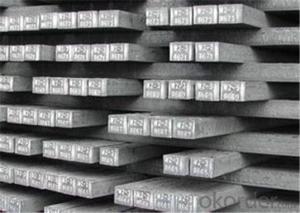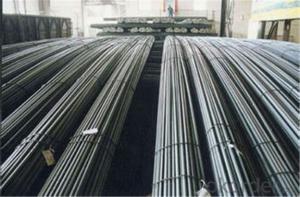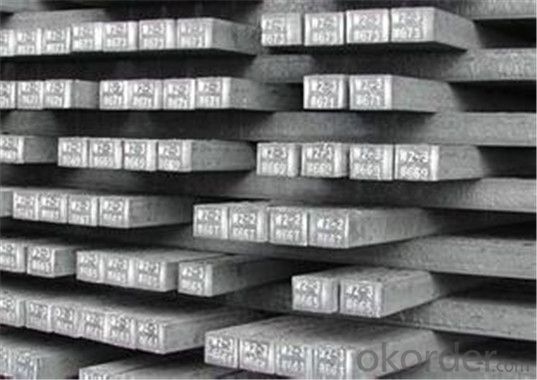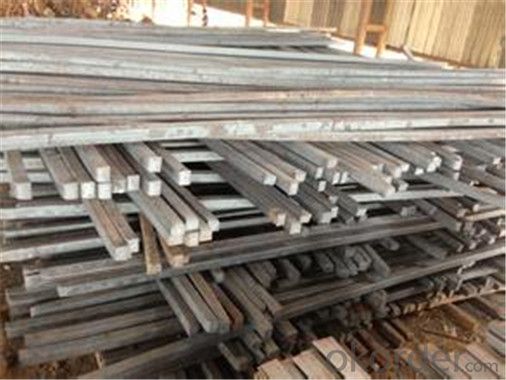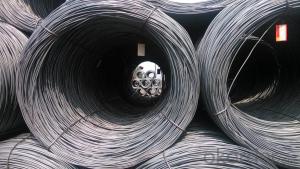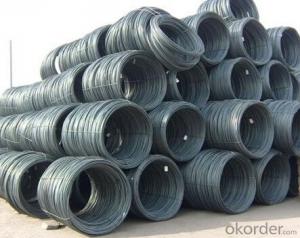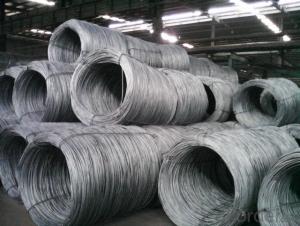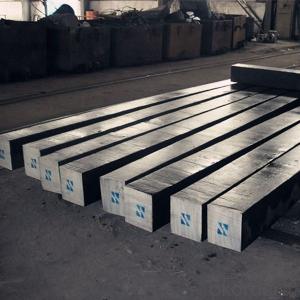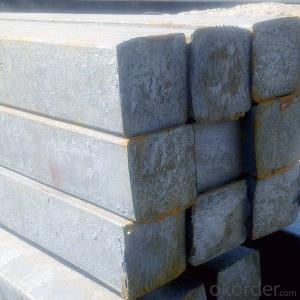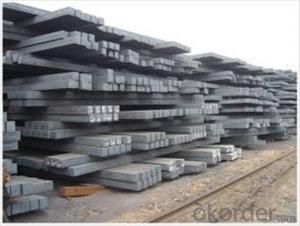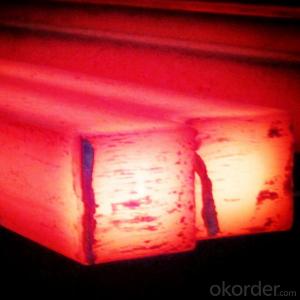Square Steel Billets Hot Sale 3SP/4SP in China
- Loading Port:
- Tianjin
- Payment Terms:
- TT OR LC
- Min Order Qty:
- 300 m.t.
- Supply Capability:
- 45555555 m.t./month
OKorder Service Pledge
OKorder Financial Service
You Might Also Like
Specification
Description of steel billet:
Our company is recognized by ISO9001:2008
1. hot rolled wire rod
2. material: Q195-235
Festures of steel billet:
Model NO.: Q195/215/235/345/45#/ASTM A36, JIS SS400
Standard: AISI, JIS, ASTM, DIN, BS, GB
Technique: Hot Rolled
Grade: Q195/215/235/345/45#/ASTM A36, JIS Ss400
Dimensions: 20*20-150*150mm
Length: 6-12m or as Required
Packaging: In Bundle
Specifications of steel billet:
Size | 60*60/90*90/100*100/120*120/150*150 |
Length | 6000mm-12000mm |
Standard | GB |
Applicaton | To produce bars or other applications |
Grade | Q195/Q235/Q275/3SP/5SP/20MnSi |
Packing terms | TT/LC |
Package | Mill's standard packing or as client's requirment |
Delivery time | Within 10-30 days after receiving the deposit or LC |
Images of steel billet:
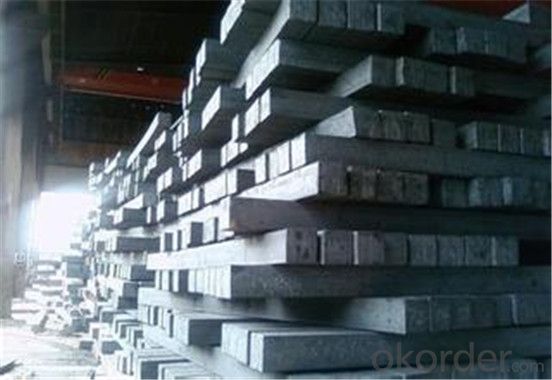
FAQ:
1. What is your package?
Packing situation: standard seaworthy packing or as customer required.
2. How long is the lead time?
Delivery time: 45 days after order confirmed.
3. What payment term do you accept?
Payment: T/T or L/C at sight.
- Q: How is steel wire rod used in the manufacturing of wire forms for musical instruments?
- Steel wire rod is an essential component in the manufacturing of wire forms for musical instruments. It serves as the base material for creating various wire shapes, such as springs, hooks, and braces, which are crucial for holding instrument parts together or providing tension. The high-quality and strength of steel wire rod ensure durability and reliability in these wire forms, enabling musicians to produce precise and harmonious sounds from their instruments.
- Q: How are steel wire rods used in the manufacturing of wire baskets for storage?
- Steel wire rods are an essential component in the manufacturing of wire baskets for storage. These rods serve as the base material from which the wire baskets are formed. They are typically made from high-quality steel, ensuring durability and strength in the final product. To begin the manufacturing process, the steel wire rods are first cleaned and then straightened to remove any bends or twists. This step is crucial to ensure that the wire baskets are formed with precision and accuracy. Once the wire rods are straightened, they are fed into a wire drawing machine. This machine gradually reduces the diameter of the rods, resulting in thinner wires. These thinner wires are then coiled onto large spools, ready to be used in the construction of wire baskets. The next step involves forming the wire rods into the desired shape for the wire baskets. This is achieved through a process called wire forming, where the wires are bent and manipulated using specialized machinery. The wire rods are carefully shaped to create the frame and mesh structure of the wire baskets. After the wire rods are formed into the desired shape, they are welded together at the joints to ensure stability and strength. Welding is crucial to ensure that the wire baskets can withstand the weight of the items stored within them. Once the welding process is complete, the wire baskets undergo a finishing process. This may include surface treatments such as galvanization or powder coating to enhance their resistance to corrosion and improve their aesthetic appearance. In conclusion, steel wire rods play a crucial role in the manufacturing of wire baskets for storage. They provide the strength and durability required for these baskets to withstand heavy loads and ensure longevity. Without steel wire rods, it would be impossible to create wire baskets that are suitable for storage purposes.
- Q: What are the different packaging options for steel wire rod?
- The different packaging options for steel wire rod include coils, spools, bundles, and crates.
- Q: How is steel wire rod used in the manufacturing of wire for telecommunications cables?
- Steel wire rod is used in the manufacturing of wire for telecommunications cables as it serves as the primary raw material for producing the wire. The wire rod is first drawn through a series of dies to reduce its diameter and increase its length, resulting in a thinner and longer wire. This drawn wire is then further processed and coated to enhance its electrical conductivity and strength. Finally, it is incorporated into the construction of telecommunications cables, providing the necessary stability and support for transmitting signals over long distances.
- Q: How is steel wire rod tested for mechanical properties?
- Mechanical properties of steel wire rod are assessed using a series of standardized tests that evaluate its strength, toughness, hardness, and other important characteristics. These tests are necessary to ensure that the wire rod meets the required quality standards and can be utilized in different applications. The tensile test is one of the main tests conducted on steel wire rod. In this test, a sample of the wire rod undergoes a gradually increasing load until it reaches its breaking point. During this process, the elongation and reduction in cross-sectional area of the wire rod are measured, enabling the calculation of significant mechanical properties such as ultimate tensile strength, yield strength, and ductility. Another commonly performed test is the hardness test, which determines the wire rod's ability to resist indentation or scratching. Various methods, including the Rockwell, Brinell, and Vickers hardness tests, are used to measure hardness. These tests provide information on the wire rod's capacity to withstand deformation and resist wear under different conditions. Furthermore, the impact test is conducted to evaluate the wire rod's ability to absorb energy and withstand fracture under high-stress conditions. This test involves striking the wire rod with a pendulum or falling weight and measuring the energy absorbed or the amount of deformation caused by the impact. Additional tests may involve bend tests, where the wire rod is bent to a specified angle without breaking, and torsion tests, which assess its resistance to twisting or rotational forces. It is important to note that these tests are typically carried out in accordance with internationally recognized standards such as ASTM or ISO. These standards provide guidelines for sample preparation, testing equipment, and reporting of results, ensuring consistency and comparability of test data across different manufacturers and laboratories. Overall, the testing of steel wire rod for mechanical properties is vital in guaranteeing its quality, dependability, and suitability for various applications in industries such as construction, automotive, and manufacturing.
- Q: What are the main factors affecting the market acquisitions of steel wire rod?
- The main factors affecting the market acquisitions of steel wire rod include supply and demand dynamics, raw material prices, trade policies and regulations, technological advancements, competitive landscape, and overall economic conditions. Additionally, factors such as the growth of end-use industries, changes in consumer preferences, and market consolidation also play a significant role in shaping the acquisitions in the steel wire rod market.
- Q: How is the diameter of a steel wire rod determined?
- The diameter of a steel wire rod is determined through a process called wire gauge measurement. This involves using a device called a wire gauge, which consists of a set of notched plates with various sizes of holes. To measure the diameter of the steel wire rod, it is passed through the holes of the wire gauge until it fits snugly in the hole without any gaps or excess space. The size of the hole that the wire fits into perfectly represents its diameter. Wire gauges are available in both standard and metric sizes, allowing for accurate measurement of steel wire rods of different diameters.
- Q: What are the different coating options available for steel wire rod?
- There are several different coating options available for steel wire rod, each providing unique benefits and characteristics. Some of the most common coating options include: 1. Galvanized Coating: This is one of the most popular coating options for steel wire rod. It involves applying a layer of zinc to the surface of the wire rod, which provides excellent corrosion resistance. Galvanized coating also enhances the durability and lifespan of the wire rod. 2. Epoxy Coating: Epoxy coating is a type of protective coating that is applied to steel wire rod to provide resistance against corrosion and abrasion. It creates a smooth and durable surface that prevents moisture and other corrosive elements from reaching the wire rod. 3. Polymer Coating: Polymer coatings are commonly used for steel wire rod that is exposed to harsh environmental conditions. These coatings provide excellent resistance against corrosion, chemicals, and UV radiation. Polymer coatings also enhance the aesthetic appearance of the wire rod. 4. Phosphating Coating: Phosphating is a chemical treatment that is applied to steel wire rod to enhance its corrosion resistance. This coating option converts the surface of the wire rod into a layer of phosphate crystals, which creates a protective barrier against rust and other forms of corrosion. 5. Powder Coating: Powder coating is a popular choice for steel wire rod that requires a decorative finish. This coating option involves applying a dry powder to the wire rod and then baking it to create a hard and durable coating. Powder coatings offer excellent resistance against corrosion, chemicals, and scratches. 6. Ceramic Coating: Ceramic coatings are often used for steel wire rod that is exposed to extreme temperatures or abrasive environments. These coatings provide excellent resistance against heat, wear, and corrosion. Ceramic coatings also enhance the strength and durability of the wire rod. It is important to choose the appropriate coating option based on the specific requirements and the intended application of the steel wire rod. Consulting with a coating specialist or manufacturer can help determine the most suitable coating option for the desired purpose.
- Q: How is steel wire rod cut to desired lengths?
- Steel wire rod is typically cut to desired lengths using various cutting methods such as shearing, sawing, or using specialized cutting machines. These methods involve applying force to the wire rod and carefully cutting it to the desired length using sharp blades or saw teeth. Some cutting machines may also use heat or lasers to cut through the steel wire rod. The cutting process ensures precise and accurate lengths as required for different applications.
- Q: How is steel wire rod tested for resistance to erosion corrosion?
- Steel wire rod is tested for resistance to erosion corrosion through various methods. One common approach is conducting accelerated laboratory tests, such as the rotating cylinder electrode (RCE) test or impingement test, where the wire rod is exposed to high-velocity fluid flow with abrasive particles. The resulting erosion corrosion is evaluated by measuring the weight loss or surface damage of the wire rod. Additionally, real-world field tests can be performed by subjecting the wire rod to actual operating conditions, such as in marine or industrial environments, and assessing its resistance to erosion corrosion based on visual inspection, surface analysis, or other relevant criteria.
Send your message to us
Square Steel Billets Hot Sale 3SP/4SP in China
- Loading Port:
- Tianjin
- Payment Terms:
- TT OR LC
- Min Order Qty:
- 300 m.t.
- Supply Capability:
- 45555555 m.t./month
OKorder Service Pledge
OKorder Financial Service
Similar products
Hot products
Hot Searches
Related keywords
